|
|
|
|
HOME DIGITAL MEDIA ARTICLES
|
Manifest Technology Blog
-- Site:
| Articles
| Galleries
| Resources
| DVI Tech
| About
| Site Map
|
Articles:
| PC Video
| Web Media
| DVD & CD
| Portable Media
| Digital Imaging
| Wireless Media
| Home Media
| Tech & Society
|
Home Media:
| Home Media Articles
| Home Networked Media Gallery
|
The Flash Storage Revolution (4/2009)
Part 2: What's Next for Flash
by Douglas Dixon
Contents
Part 1: The Growth of Flash
Part 2: What's Next for Flash
For earlier round-ups of interesting products, see my related articles:
References:
Flash-based Solid State Drives (SSD) are encroaching on the
domain of hard disk drives (HDD). SSD has a compelling story: it's more rugged
(with no mechanical parts or spinning platters), more power efficient (with 10
to 15 percent longer battery life), weighs less, and offers significantly faster
performance -- so your system can start up and launch applications twice as
fast.
Hard drives do still offer higher capacity and lower cost,
but the gap is shrinking. SSD also did have a concern about flash storage wearing out after
too many write operations, but the industry has advanced the technology to have
lifetimes on par with hard drives.
Solid State Drive (SSD) Benefits vs. Hard Disk Drives (HDDs)
- Reliability - Rugged to shock from drops, no moving mechanical
parts
Withstand more heat, vibration and shock than a HDD
Mean Time to Failure (MTTF) 2 million hours, up to 6 X
HDDs
- Performance - Boots and launches applications faster, up to 2X HDDs
- Power/Efficiency - Run much quieter and cooler than HDDs
Consume 1/2 the power of HDDs (spin when idle)
Result in 10-15% longer battery life (up to 30 minutes
per charge)
- Less Weight - Weigh 44 grams, less than 1/2 HDDs
You can look forward to next notebook having SSD storage,
but the industry sees plenty of use for SSD right away. SSD is moving
from an extra-cost option (as in the Apple MacBook Air) to a cost-effective
option for upgrading older systems. For example, instead of replacing an old
laptop, you can swap in a SDD drive to make the systems feel young again, with a
clearly visible performance boosts for disk-intensive operations.
Notebook Hard Disk Capacity Growth
SSD is reaching capacities required for mainstream use in notebooks

From NAND Flash: The Ubiquitous Storage Medium,
Samsung Semiconductor,
www.samsung.com/us/business/semiconductor
Flash Memory Summit, 8/2008, www.flashmemorysummit.com
Solid State Drives Reaching Hard Disk Pricing
SSD is dropping to price range required for mainstream use in notebooks

From Memory Storage Through The Global Recession,
Samsung Semiconductor,
www.samsung.com/us/business/semiconductor
at Storage Visions 2009, http://www.storagevisions.com/2009/Book/Jim%20Elliot.pdf
SanDisk Solid State Drives - G3 SSD - to 240 GB (mid-09)
Drop-in replacement for hard disk drive, thin and light notebooks
Superior durability and higher performance, particularly for OS boot and
application load
|
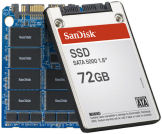
|
- SanDisk G3 SSD Family - 3rd gen - 60, 120, 240 GB, 2.5" and
1.8" (09)
Over 100 years of typical user usage, 6X more reliable
than HDDs
More than 5X faster than fastest 7,200 RPM HDDs
2X faster '08 SSDs, 40,000 vRPM, sequential read 200 MB/s
, write140 MB/s
1/09 - 60 GB $149, 120 GB $249, 240 GB $499
- SSD SATA 5000 2.5", up to 64 GB (07)
- old 07 - SSD SATA 5000 1.8", 5 mm height, lighter and power
efficient, to 72 GB
- G3 PR 1/09 - www.sandisk.com/Corporate/PressRoom/PressReleases/PressRelease.aspx?ID=4478
- www.sandisk.com/OEM/ProductCatalog(1274)-SanDisk_SSD_Solid_State_Drives.aspx
|
Imation Solid State Drives: M- and S-Series (~ 4/09)
SSD unit, plus upgrade kit with connector and software to migrate from
existing hard disk
|
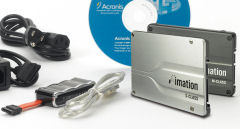
|
- Capacities: 32, 64, 128 GB, 256 and 512 GB later this year
- Form factor: 2.5-inch and 3.5- inch
- M-Class SSD for PC and & Laptop users
Read 150 MB/s, Write 90 MB/s, SATA 1.0
- S-Class SSD for Commercial and Enterprise, Higher performance &
energy efficiency
Read 130 MB/s, Write 120 MB/s, SATA II - 3.0 Gbps
- SSD Upgrade Kits: M-Class & M-Class
- Imation SSD, power cable, USB-to-SATA or SATA connector
cable
- Acronis True Image HD software for migrating from
existing hard drive
operating system,
applications, data
- PR 1/09 - http://www.imation.com/en/About-Imation/News/January-2009/...
- www.imation.com/en/Imation-Products/Solid-State-Drives
- www.imation.com/en/Imation-Products/Solid-State-Drives1
|
Top
Simpler, portable, less expensive, focused on Internet access
Netbook PCs taking off: 500,000 in 2007
to 18 million in 2009 (SanDisk/Taiwan MIC)
- See my Portable
Communications Gallery - Netbooks
Netbooks are small and inexpensive notebook sstripped down to focus on portability and significantly lower cost.
Netbooks are all about online access, for browsing websites and keeping in
touch with e-mail, but also run versions of Windows or Linux so you can edit
documents and the like.
In comparison, "ultraportable" notebooks like the Apple MacBook Air
and Sony VAIO TT series feature larger displays
and better performance, and weigh closer to 3 pounds, but at premium prices ($1800 and up).
Netbook features
- Portability -- around 2 to 3 pounds
- Inexpensive - around $500
- Simpler software - Windows XP Home or Linux
- Smaller display - 7 to 10 inch
- Smaller size - scrunched keyboards
- Reduced performance - low-power processors like the Intel Atom, more limited
memory and storage
- No CD/DVD drive
References
Laptop vs. Desktop PCs (unit sales)
60 / 40 Ratio Has Reversed
- 2005 - Desktop 58%, Laptop 42%
- 2009 - Desktop 37%, Laptop 63%
- From Global CE Sales & Forecasts, Consumer Electronics Association,
CES 1/09 - www.ce.org
Consumer PC Market: Desktop, Notebook, Netbook
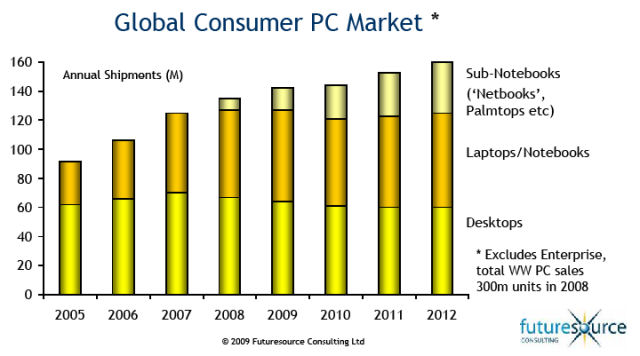
Courtesy Futuresource Consulting, www.futuresource-consulting.com
Netbook Operating Systems
ABI Research 1/09 - 2009 netbook worldwide shipment forecast nearly 35
million, estimated 139 million in 2013
ABI Research - 4/09 - The Down Economy Could Give Alternative Netbook Operating Systems a Hand Up
- www.abiresearch.com
- 75% of netbooks shipped in 2008 ran Windows XP
- 2012 will see the tipping-point at which netbooks running Linux-based
and mobile operating systems
outnumber those running Windows XP
Netbook sales may not be adversely affected - in fact may actually be
helped - by the recessionary pressures. There are three reasons for this.
First, netbooks are a fairly new class of device, and widespread adoption has
only recently begun. Second, they are relatively inexpensive, and some consumers
may see them as a viable alternative to that pricey laptop they originally
intended to buy. Finally, they can run inexpensive operating systems that don't
require powerful hardware.
While much recent media attention has been focused on the trend to beef up
netbooks and make them more laptop-like (and more expensive), the more important
change has been at the lower end of this market. To create a lower-cost device
designers are turning to Linux, and, for netbooks with ARM processors, to any of
several mobile device operating systems such as Android. Mobile OSs such as
Android, Windows Mobile, and Maemo can still provide the core functionality
required of a netbook, but at lower cost and with smaller storage and memory
requirements.
- See my Portable
Communications Gallery - Netbooks
Sample Netbook Computers
ASUS Eee PC - 2007
The netbook market started growing with the introduction of the ASUS Eee PC
in 2007, starting at $299. For around $399, the Eee PC 710 weighed 2 pounds with
a 7 inch screen, and was (under-)powered by an Intel Celeron processor, 512 MB
RAM, and 4 GB solid-state drive. But it was easy to use and quite responsive
with Linux applications and Wi-Fi networking.
One Laptop Per Child (OLPC) XO - 2007
Rugged, low-cost, low-power, connected laptop developed by the MIT Media Lab.
Released 11/2007.
ASUS Eee PC 1000HE - 10", 160 GB, 3.2 lbs., 9.5 hours, $399 (1Q 09)
|

|
- 9.5 hours battery life, ASUS Super Hybrid Engine power efficiency options
- 1/09 Preview, 4/09 - $399 / $389
- 10" LED backlight display, 1024 x 600 (WSVGA)
- 160 GB HDD, 10 GB Online Eee storage
- Intel Atom 1.66 GHz N270 / N280, 1 GB RAM
- 1.3M Pixel camera - Skype or any other Instant Messaging client
- 92% size of generic keyboard
- Windows XP Home, Microsoft Office Home & Student 2007 60-day
trial
- 266 x 191.2 x 28.5 ~ 38 mm, 1450 g (3.20 lbs)
- http://eeepc.asus.com
 Find the ASUS
Eee PC 1000HE on Amazon.com
Find the ASUS
Eee PC 1000HE on Amazon.com
|
Dell Inspiron Mini 9 (9/08)
|

Courtesy of Dell Inc.
|
- Glossy 8.9 inch LED display (1024 x 600)
- Intel Atom N270
- 512 MB to 1 GB RAM
- SSD: 4 GB, 8 GB, 16 GB (Linux only)
- Wi-Fi 802.11g mini-card, AT&T built-in cellular mobile
broadband (optional)
- Bluetooth Internal (2.0) mini-card (optional)
- Webcam 0.3 - 1.3 MP (optional), bundled with Dell Video Chat
- Speaker, no optical drive
- Windows XP Home SP3 or Ubuntu Linux 8.04 with custom Dell
interface
- Battery life 4 hours
- Inspiron Mini 9 -
www.dell.com/content/products/productdetails.aspx/laptop-inspiron-9
 Find the Dell
Inspiron Mini 9 on Amazon.com
Find the Dell
Inspiron Mini 9 on Amazon.com
|
- Inspiron Mini 9 - 9/08 - 8.9 inch display, 2.28 lbs. - starting
at $279
Bundle with two-year AT&T LaptopConnect agreement
- $99 (regularly $449, after $350 mail-in rebate)
- Inspiron Mini 10 - 2/09 - 10.1 inch WSVGA widescreen display, 2.86
lbs, starting at $399
- Inspiron Mini 12 - 11/08 - 12.1 inch WXGA display, 2.72 lbs., starting
at $399
- Box.net web-based file storage, free 2 GB, upgrade to 25 GB, www.box.net/dell
Safely and securely upload files of any type, access
files from almost anywhere on any device
No software to download, edit documents and photos
directly from web browser
- Dell Netbooks - www.dell.com/home/netbooks
Sony VAIO P series Lifestyle PC - $900 Netbook (2/09)
Upscale "lifestyle" Sony PC fits in a jacket pocket or a handbag
-- Just don't call it a "netbook"
The Sony VAIO P series Lifestyle PC has an 8 inch
display, and weighs only 1.5 pounds. It
includes both Wi-Fi and mobile broadband (with cellular subscription), plus GPS.
It is priced at $899 with a 60 GB HDD, $1199 with a 64 GB SSD, and $1499 with
128 GB SSD -- still a premium for the solid-state drive, but with larger
capacity than the available hard drive.
|
 |
- 8 inch display, 1.4 lbs.
- 1.33 GHz Intel processor, 2 GB RAM
- Wi-Fi , Mobile Broadband (with cellular subscription), GPS
- Built-in webcam and microphone
- Instant-mode boot for music, video, photos, Web
- Windows Vista Home Premium or Home Basic
- 4 hour battery life
- 4.72 x 9.65 x 0.78 inches, 1.5 pounds
- 2/09 - $899 60 GB HDD, $1199 64 GB SSD, $1499 128 GB SSD
- www.sony.com/vaio
 Find the Sony
VAIO P on Amazon.com
Find the Sony
VAIO P on Amazon.com
|
Apple MacBook Air - $1800 Ultralight Notebook (1/08)
Compare Apple ultralight notebook
|
 |
-
13" display, full-sized keyboard and thin (3/4 inch) and light (3.0
lbs)
- No optical drive, 80 GB HDD, limited connectors (no video out
, Ethernet)
- 4/09 - 1.6 GHz, 2 GB, 120 GB HDD, $1799; 1.86 GB, 128 GB SSD $2499
- 1/08 - 1.6/1.8 GHz, 2 GB, 80 GB, $1799
- www.apple.com/macbookair
- See article: Sony 2008 VAIO
Notebooks (and Apple MacBook Air)
 Find the Apple
MacBook Air on Amazon.com
Find the Apple
MacBook Air on Amazon.com
|
Top
Smartphones and Convergence Devices
All-in-one devices: Phone + Media player + Camera + Internet + PDA + GPS ...
Netbooks are just one vision of the once-hyped "convergence" of
computing, communications, and entertainment -- combining a mobile phone, PDA,
Internet access, portable media player, and camera. In this way, netbooks are
positioned more as competition for smartphones, with the larger screen and
near-full-size keyboard for extended usage.
Plus there are other kinds of multi-functional digital devices. Handheld game units like the Nintendeo DS line and Sony PSP have a
significantly expanded view of entertainment, and E-book
readers like the Amazon Kindle and Sony Reader also can display music and
photos.
A smartphone provides take-everywhere Internet access, rather than an
almost-everywhere device like a netbook, which really does not fit unobtrusively
in a pocket. And you may need a full-up notebook anyway for business travel. And
it may not make sense to integrate all these functions
into a single device, compared to having separate dedicated devices for
occasional activities such as listening to music, shooting better-quality photos
and videos, and GPS navigation.
Mobile Internet Device Market Trends
Integrate / converge into single device -- Communications, Media,
Internet
Broadband wireless Internet - WiMax, LTE
Mobile Internet Device? Pocketable Computing Device? Personal Computing Device?
SanDisk - Smartphones with Storage
- Smartphones will account for 28% of wireless shipments in the U.S.
in 2008 (SanDisk/CEA)
- 80% of cell phones will have memory slots by 2012 (SanDisk/Gartner)
- 20% of computing devices will have solid state drives by 2011/2012
(SanDisk/Gartner)
Mass Quantities of Mobile Devices
- 2.5 billion cell phones worldwide (500 million with Internet service)
- 100 million mobile computers
- 600 million Internet-connected PCs
- By 2010, over 1 billion wireless Internet devices (cell phones, PDAs,
laptops, and sensors)
- See article - Next-Generation
Wireless: LTE & WiMAX
Broadband wireless - LTE & WiMAX
- LTE (Long Term Evolution) - 10 to 20 Mbps to users when deployed in
2010, potential of 40 to 100 Mbps
- WiMAX - Downloads 1 to 5 Mbps, total capacity up to 40 Mbps, up to
15 Mbps for mobile networks
- See article - Next-Generation
Wireless: LTE & WiMAX
Parks Assoc., 1/09 - Fixed-Mobile Convergence
- 3G subscribers exceed 2.5 billion worldwide by 2013, over one billion
in Asia alone
- Chart - www.parksassociates.com/research/reports/tocs/2008/fixedmobileconvergence.htm
The tremendous expansion of this large service population will catalyze the
development of fixed-mobile convergence (FMC), creating new service options
where users can access video, audio, and community offerings via mobile devices
once limited to traditional voice applications.
IDC, CES 1/09, Semiconductor Demand and Technology Adoption in CE and
Mobile Devices, www.idc.com
- Internet users: 1.4 billion 2008, 2
billion 2012
- Internet devices: 1.5 billion 2008, 3 billion 2012 - Almost
half connected by 2012
- 3G/4G/WiMax subscribers over 1.4 billion by 2012 - Wireless
broadband (100 Mbps)
ABI Research 1/09 - 1.21 billion handsets shipped in 2008, for annual
growth of 5.4%, 2007 was 16%
Nokia 38.6%, Samsung 16.2%, LG 8.3%, Sony Ericsson
8.0%, Motorola 8.3%
RIM 1.9%, Kyocera 1.4%, Apple iPhone 1.1%, HTC 1.1%, Sharp
1.0%, Other 14.1%
ABI Research 1/09 - GPS-enabled Handsets
Global handset shipments expected to drop 4-5% in 2009,
GPS-enabled phones will increase 6.4% to 240 million units
Demand for smartphones will increase at average annual unit
shipment rate of 19% through 2014
90% of smartphones will contain
GPS ICs in 2014, compared with one in three in 2008
Smartphones Expand Mobile Phone Market
Mobile phone market still growing, as smartphone segment starts to expand

From Memory Storage Through The Global Recession,
Samsung Semiconductor,
www.samsung.com/us/business/semiconductor
at Storage Visions 2009, http://www.storagevisions.com/2009/Book/Jim%20Elliot.pdf
LG Touch Watch Phone (1/09)
Watch, plus touch screen phone (1.4"), MP3 player, organizer
Raise wrist towards mouth to talk (Dick Tracy), or Bluetooth headset
Stereo Bluetooth (for headsets), speaker (speaker phone,
music)
|

|
- Voice recognition, with or without Bluetooth headset
Voice calling: Push button, "call home"
- Camera for photos, video phone calls
- MP3 player, volume slider on screen
- Text to Speech (TTS) reads text messages and other
information
- Organizer: Large phonebook and scheduler, Flash interface
- On sale in Europe 2nd half 2009
- PR 1/09 - www.lge.com/about/press_release/detail/21062_1.jhtml
- Engadget hands-on: www.engadget.com/2008/01/06/....
|
Verizon Wireless / RIM BlackBerry
Storm Smartphone (11/08) -- Enterprise + multimedia
BlackBerry navigation keys (phone, menu, escape)
SurePress 'clickable' touch-screen with multi-touch gestures
Feel screen being pressed and released with a gentle
'click' (like physical keyboard)
Accelerometer: Automatically switch landscape and portrait when rotated
|

|
- 3.25" color display, 3.2 MP camera
- 11/08 - $199 w/ $50 rebate, 2 year activation
- 1 GB memory, microSD slot (8 GB included, up to 16 GB)
- Multi-task while on the phone - Use email, browse
Web,
update GPS directions or maps, take and send photo
- Organizer: Calendar, Address Book, Task List, MemoPad,
Calculator
Sync with BlackBerry Desktop Software
- Blackberry Device Software 4.7 - View and edit Microsoft Word,
Excel, PowerPoint
- Personal and corporate e-mail with attachments, messaging
- GPS: BlackBerry Maps, www.blackberry.com/maps
VZ Navigator with turn-by-turn directions
- Web browser: Full HTML or mobile
- Sync desktop iTunes music files with BlackBerry Media Syn
- Global connectivity: Global phone and e-mail
- 4.43 x 2.45 x 0.55", 5.5 oz (112.5 x 62.2 x 13.95,
155g)
- www.blackberry.com/storm
- www.verizonwireless.com/storm
-
 Find the Verizon
/ BlackBerry Storm on Amazon.com
Find the Verizon
/ BlackBerry Storm on Amazon.com
|
Apple iPhone (6/08) - iTunes sync
|

|
- 6/08 - iPhone 3G - 16 GB $299; 8 GB $199
3G networking 2X faster, built-in GPS, iPhone 2.0
software -
- 3.5 inch (diagonal) widescreen multi-touch display, 480 x 320
- 4.7 ounces
- Touch-screen Mobile phone
- Widescreen iPod with touch controls, Cover Flow interface
- Internet communications device
- 2 megapixel camera
- Built-in Accelerometer, Proximity sensor, Ambient light
sensor
- AT&T
- www.apple.com/iphone
|
T-Mobile G1 / Google Android (10/08) -- Sync with the cloud
Sync with Google applications: Google Search, Gmail, Google Calendar, Google Talk,
YouTube
|
 |
- 10/08 - $179
3.2-inch flat touch-sensitive screen, 320 x 480
- Hinged screen slides up to reveal QWERTY keypad
- 3.2 MP camera, fixed focus
** No built-in video recording, playback (beyond
YouTube)
- Full HTML Web browser
- Instant Messaging/text/e-mail
-
Google Maps, Compass mode
- Reads MS Word and PDF documents
- ** No Exchange
(enterprise e-mail)
- ** No desktop sync
- Music player ** No built-in video playback
- GPS navigation: built-in GPS receiver and map software
- microSD memory card expansion slot (SD 2.0 compatible)
- HTC ExtUSB (audio jack) ** No
standard headphone jack
- T-Mobile 3G and EDGE network, and Wi-Fi IEEE 802.11b/g
- Removable battery
- 5.57 oz with
battery
- Android Market - www.android.com/market
- T-Mobile G1 - www.t-mobileg1.com
- HTC G1 - www.htc.com/www/product/g1
- Open Handset Alliance - www.openhandsetalliance.com
|
Windows Mobile Smartphones
Verizon Wireless Samsung Omnia (SCH-i910) - Touch screen, 5 MP (11/08)
All-in-one mobile device: Business + multimedia, Wi-Fi, 5.0 MP
camera
Windows Mobile 6.1 with touchscreen, haptic feedback,
TouchWiz interface, customizable drag-and-drop widgets
Verizon Wireless HTC Touch Pro (XV6850) - Touch Smartphone (4/09)
Windows Mobile with touchscreen, TouchFLO 3D interface,
Wi-Fi
Slide-out QWERTY keyboard, Portrait and landscape orientation
Sprint / Palm
Pre (1H/09) - Multi task, Multiple
personalities, Bridge office and personal
Synergy feature: Apps communicate dynamically to web
Integrated view: Contacts, calendar, e-mail, messaging from multiple sources
"Card" model: Switch easily between multiple
activities
Universal search: Start typing to search contacts,
apps, then Google, Wikipedia
|

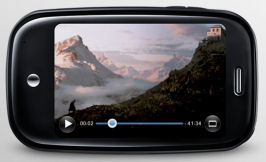
|
- Gesture / multi-touch user interface
- Available exclusively from Sprint for U.S. in first half 2009
- 3.1" touch screen, 24-bit color, HVGA 320x480
- Slide-out QWERTY keyboard
- Slide out keyboard for faster texting and e-mail
Close & rotate for widescreen music, websites,
photos
- 8 GB memory ** NO expansion card slot
- 3 MP camera, LED flash ** NO video capture or
voice record?
- Ambient light sensor, accelerometer, proximity sensor
- Wi-Fi, GPS
- Microsoft Outlook email, Integrated messaging
- Media player, Web browser
- MicroUSB connector with USB 2.0 Hi-Speed
- Removable, rechargeable battery
- Palm Touchstone wireless charging dock accessory
- 4.76 ounces
- CES Announcement video - www.palm.com/us/products/phones/pre/ces-video.html
- PR 1/09 - http://investor.palm.com/releasedetail.cfm...
- Palm - www.palm.com/us/products/phones/pre
- Sprint - www.sprint.com/palmpre
- See full article: Palm
Pre Preview
|
Top
Portable game systems as media players
Handheld game units like the Nintendo DS line and Sony PSP have a
significantly expanded view of entertainment -- the PSP also is a media player
(including full-length movies) and Web browser, and the new DSi plays and
captures music and photos -- and allows you to edit them with fun effects to
share wirelessly with friends.
1/09 - Total units sold: 96 M Nintendo DS, 50 M Sony PSP, 30
M Apple iPhone / iPod touch (4/09 - Engadget)
Sales History
- 4/09 - Nintendo has sold 75 million DS units since the product
launched in 2004 (CNBC)
- 4/09 - Nintendo sold 600,000 DSi units across North America and
Europe during first few days of availability (GameDaily)
DSi has sold over 2 million units in Japan since
it went on sale there in November 2008
- 6/08 -Sony PSP - 41 million units sold
worldwide
3/07 - 25M units sold, 100 million software units
Ninty's sold just about twice as many total DS units than Sony's 50m PSPs,
hard numbers from which no amount of marketing bluster can really distract. In
fact, if we were in charge at Sony, we'd be more worried about the emergence of
the iPhone and iPod touch, which have sold over 30m uni
Nintendo DSi (4/09) -- Play and share with photos and music
"More than a game system, more of a personal tool to enrich our
daily lives"
|
 |
- Larger 3.2 in. screens
- Two VGA / 0.3 MP cameras, interior hinge points towards user,
exterior shell
- Audio player: Music player (AAC , not MP3) - adjust speed and
pitch, apply filters
Voice recorder - Modify 10sec. sound clips, apply
to songs
- Camera software: Apply lens effects to photos
View photo albums and slideshows, edit photos,
Trade wirelessly
- Web browser, DSi Shop - games and applications,
Prices free to $8, max $20
- SD/SDHC expansion card slot (not Game Boy Advance)
- ARM 133 MHz CPU, 16 MB RAM, 256 MB internal Flash memory
- 4/09 US - $169/$149, blue or black
- Wikipedia - http://en.wikipedia.org/wiki/Nintendo_DSi
- www.nintendodsi.com
 Find the Nintendo
DSi on Amazon.com
Find the Nintendo
DSi on Amazon.com
|
Nintendo DS Lite (6/06) / DS (04)
|
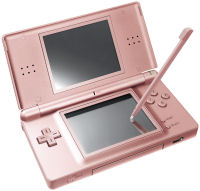 |
Nintendo DS Lite (6/06)
- Slimmer and lighter, brighter screen (4 levels); 6/06 US - $129
Nintendo DS (04)
- Stereo speakers, built-in microphone
- Wi-Fi 802.11 to interact with near-by players
online with Nintendo Wi-Fi Connection service
- Backwards compatible with Game Boy Advance
cartridges
- Released North America 11/04 - $149, 8/05 $129
- www.nintendo.com/ds
|
Sony PlayStation Portable (PSP)
|

- Handheld gaming machine
+ Movie player for
films on UMD disc
+ Personal media player: Music, photos, video
+ Wi-Fi networking
- 12/06 - PSP-1000 launch
-
9/07 - PSP-2000 - slimmer and lighter, video out
-
11/08 - PSP-3000 - enhanced display, microphone
- www.us.playstation.com/PSP
|
Sony PSP-3000 (11/08)
- Enhanced display, contrast ratio,
color gamut
built-in microphone for voice input,
Skype phone
- 4.3 inch display, 64 MB, Memory Stick PRO Duo slot
- Wi-Fi wireless - Infrastructure mode,
Ad hoc
mode (up to 16 consoles)
Web browser (Flash content), Internet radio,
RSS feeds (streaming audio and
video)
Remote play (access PS3)
PlayStation Network -
buy games and content
- MPEG-4 Video, MP3 / WMA audio, photos
- 8/08 - $199
 Find Sony
PSP-3000 on Amazon
Find Sony
PSP-3000 on Amazon
|
E-book readers also can display music
and photos
There's another type of portable media -- plain old text. And between e-mail and the Web browser on our PDA
phones, we're actually doing a lot of reading on our devices, even though that's
not the focus of their design. Meanwhile, Amazon and Sony have been working on a different category of
device, e-book readers that are also on the convergence track, with better
displays, audio playback, photos, and wireless connectivity.
Sony Reader Digital Book (10/08)
Touch screen display, size like thin paperback book
Sony eBook Store, plus access 500,000 free public domain books from Google
http://ebookstore.sony.com/google-ebooks
|
 |
- PRS-700, 3rd generation
- 6 inch touch-screen display, 8-Level Gray Scale, 170 Pixels Per Inch
- Transfer eBooks, documents (Word, PDF)
Music
(MP3, AAC), Photos: JPEG, GIF, PNG, BMP
- Memory Stick Duo / SD card expansion storage
- 0.4 in. thin (5 1/9 x 6 7/9 x 13/32
in.), 10 oz.
- Battery - turn up to 7,500 pages (two weeks of reading)
- Announced 10/08 - $399; 4/09 - $349
- PR 10/08 - http://news.sel.sony.com/en/press_room/consumer/
computer_peripheral/e_book/release/37586.html
- www.SonyStyle.com
 Find the Sony
Reader on Amazon.com Find the Sony
Reader on Amazon.com
|
Amazon Kindle 2 (2/09)
Purchase and download books
directly to device, 1 min. delivery (Sprint broadband
wireless, no extra monthly charge)
Download some 230,000 books directly from Amazon, U.S. and
international newspapers, magazines, blogs
Explore and preview books by downloading first chapters
for free
Sync Audible recorded books via PC, transfer personal documents via online
service (Word, PDF)
Web
browser, best used for simple, text-centric Web sites
|
 |
- 6 inch display (not touch screen), 600 x 800, 167 ppi,
Upgraded
from 4 to 16 levels of gray for clearer text, crisper images.
- Half as thin,
just over 1/3 of an inch (8 x 5.3 x 0.36 in.), 10.2 oz.
- More storage, hold over 1,500 books (no memory card expansion)
- Play MP3 music, display image files
- Runs up to 4 days with wireless on, 2 weeks with wireless off
-
"Experimental" Text-to-Speech, read books
out loud
- Released 2/09 - $249
 Find the Amazon
Kindle 2 on Amazon.com Find the Amazon
Kindle 2 on Amazon.com
|
Top
Portable and home, Flash and the cloud
Consumer Digital Storage
Home & portable - Total consumer storage usage: Optical disc, hard drive, and
flash
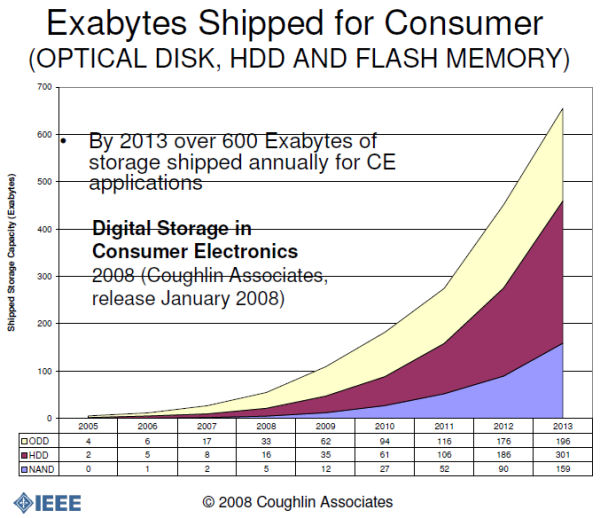
From Storing Your Life Consumer Digital Storage-
Personal, Shared, Hierarchical and Virtual
Coughlin Associates, January 2008
www.tomcoughlin.com/Techpapers/Storing%20Your%20Life%20for%20UCSC,%20100108.pdf
Digital Storage In Consumer Electronics
- By 2015 overall consumer content could add up to about 760 exabytes
worldwide, including commercial, personal as well as shared content
- Projections based up on a consumer survey show that we could expect
over 2.2 TB of new content in an average home in 2013 including backups
- By 2013 total content in an average home could total almost 9 TB. 5
TB of this is commercial content
- Projections for the upper 10% most active users of content in the
home could easily see their storage capacity requirements double those of
the average user
- After 2010 Life Logs and other new content capture and sharing
technologies could drive the use of storage capacity for user generated
content to enormous levels
- Most mobile applications will migrate to flash memory except where
higher storage capacities are required for mobile library content or higher
resolution video is captured (such as in higher resolution, longer use time
camcorders)
- Total digital storage device capacity for all storage devices shipped
into the home could reach 650 exabytes by 2013. At the same time
expected accumulated consumer data by 2013 is expected to be about 760
exabytes.
- Coughlin Associates, January 2008
www.tomcoughlin.com/Techpapers/Brochure
CE_Storage_Report, 010208.pdf
Cloud Storage
Netbooks with Online Storage
"Hybrid" storage - Local HDD / SSD + online
ASUS Eee PC
Dell Inspiron Mini
- Box.net web-based file storage, www.box.net/dell
- Lite - Always Free - 2 GB of storage, 25 MB file uploads, 5
collaboration folders
Professional - $99.99 / year - 25 GB of storage, 1 GB file uploads, 10
collaboration folders
+ 24/7 phone support, Faster Uploads, Version history
- Business - $15 / user / month - 15 GB of storage, 1 GB file uploads,
Unlimited collaboration folders
+ Custom branding, Admin console
LaCie Goes Online with Wuala (3/09)

- 3/09 - LaCie Merges with Caleido AG, the creators of the Wuala
social online storage service
- Reliable and secure cloud storage
Store and back up files, Access and share anywhere from
the Web
- Start with 1 GB, can get as much as you want
Trade idle disk space (i.e., 50 GB on your
computer for 50 GB online)
Buy additional storage: 10 GB $25/year, 100 GB
$100 / year, 1 TB $1000 / year
- Based on technology researched at ETH Zurich (Swiss Federal Institute of
Technology Zurich)
- All data first encrypted on user's computer
split into fragments, redundantly stored on servers
and in grid network
128 bit AES for encryption, 2048 bit RSA for
authentication
- Upload in background, fast download P2P in parallel
- Desktop client (Java) to drag-and-drop files and upload in the background:
Windows, Mac, and Linux
- LaCie morphs from pure hardware manufacturer to solution provider
Sees combined solution for storage
Local storage on devices for fast
access,
Secured remote storage on the
cloud, for easy sharing and complete data versatility
- PR 3/09 - www.lacie.com/us/company/news/news.htm?id=10468
- www.lacie.com
- www.wuala.com
Flash Storage
Western Digital Enters Solid-State Drive Market - Acquires SiliconSystems



- 3/09 - WD acquires SiliconSystems, $65 million cash acquisition
- Western Digital is a leader in hard drive storage for computing and
consumer electronics
- SiliconSystems is leading supplier of solid-state drives for the embedded
systems market
- Solid-state drive market estimated $1.1 billion in 2008, embedded
systems largest segment at $400 million
- Sold millions of SiliconDrive products
SATA, EIDE, PC Card, USB and CF interfaces, in 2.5-inch,
1.8-inch, CF and other form factors
- Addresses emerging opportunities in WD's existing markets
Accelerates programs for netbook, client and
enterprise markets
- PR - 3/09 - www.wdc.com/en/company/releases/pressrelease.asp?...
- www.westerndigital.com
- www.siliconsystems.com
demo
Top
|
